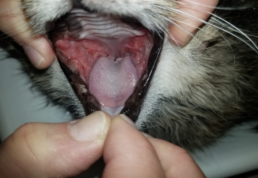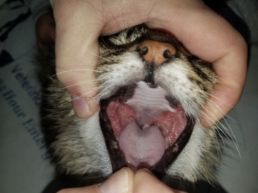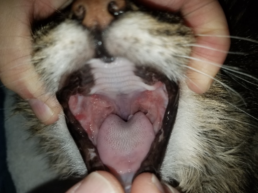Case Summary
Charlie, an 11-yr-old MN DSH, was treated for feline gingivostomatitis with full mouth extractions. Following the extractions, the oral inflammation continued, creating a revised diagnosis of refractory gingivostomatitis. For almost two years Charlie was medically managed with a combination of steroids, cyclosporine, narcotic pain medicine, and chlorambucil. During this time, his oral inflammation was marginally under control, but the patient continued to experience pain from his inflammation, and even developed transient diabetes from the steroids. He was miserable.
At that point in time, 4 x 15 min/day treatment with the Assisi Loop Lounge was instituted in addition to his other medical therapies. Over the next 8 months, Charlie’s condition improved dramatically. Within a month, the oral inflammation was starting to improve, as was Charlie’s comfort level. Improvement continued over the following 6 months to a point where the oral inflammation is almost completely resolved, and the medical therapy has been significantly reduced.
In the case of Charlie, it appears that the positive turning point in treatment of his refractory gingivostomatitis was the institution of the Assisi Loop Lounge.
Case Specifics
1. Charlie is an 11-year-old male neutered Domestic Long Hair cat who was initially presented on April 11, 2018 for treatment of previously diagnosed Feline Gingivostomatitis. He had total mouth extractions on that day, with radiographic confirmation of complete root removal.
2. Charlie was rechecked routinely since his procedure, but the inflammation and proliferation in his caudal mouth were persistent and worsening. He had stopped grooming and would intermittently gag and sometimes vomit. His appetite was poor to absent. Charlie’s diagnosis at that time was refractory gingivostomatitis.
3. Charlie’s caudal mouth had bilateral erythema and proliferation. He was cachexic and his haircoat was greasy and unkempt.
4. Treatments were as follows:
- Convenia and Mirtazapine were given within the first weeks post-operatively
- DepoMedrol had been administered post-operatively, but was discontinued when Charlie developed transient diabetes
- Triamcinolone 2mg/ml: 0.5 cc SID starting 12/12/2019
- Chlorambucil 4mg/ml: 0.5 cc EOD starting 8/16/2018
- Cyclosporine 100mg/ml: 0.5 cc SID starting 5/31/2018
- Buprenorphine 0.3 mg/ml: 0.2 cc PO q8-12 hours PRN pain.
- Assisi Loop trial; 4 X 15 mins/day starting Jan. 16, 2020.
As of 1/29/2020, the erythema in Charlie’s caudal mouth started to improve. He enjoyed his time in the Assisi Loop Lounge when it was paired with a catnip toy.
As of 2/12/2020, the erythema in Charlie’s caudal mouth was scant and although the proliferation was unchanged, he was eating better and gaining weight. He was starting to lose patience with the Assisi Loop Lounge.
As of 2/26/2020, the erythema was only present in a ~3mm area on the right caudal fossa, but the proliferation was unchanged, and he continued to gain weight. His haircoat appeared less greasy. Charlie had begun grooming the other cat and sitting with his owner on the couch. Triamcinolone was decreased from SID to every other day.
As of 3/25/2020, the erythema worsened again to appear diffusely mottled, and the proliferation was unchanged. Charlie continued to gain weight. He was chasing the dogs and sitting with the other cat on the windowsill. His Triamcinolone was increased back to SID.
As of 4/22/2020, the erythema further worsened to be more diffuse, and the proliferation was unchanged. Charlie continued to gain weight, and to sit with the other cat in the windowsill. Treatment was maintained.
As of 5/13/2020, the erythema improved, and the proliferation was unchanged. Charlie lost a little weight, and while he continued to sit with the other cat on the windowsill, he had become fussy about the Assisi Loop Lounge and only tolerated two treatments on some days.
As of 6/10/2020, the erythema was resolved but the proliferation was unchanged. Charlie gained weight again and continued to do well clinically. He tolerated the Assisi Loop Lounge after being chased by his owner. His Buprenorphine was decreased to only be given PRN.
As of 7/15/2020, the erythema continued to be resolved and the caudal mouth proliferation was unchanged. He was active and sociable with his family. He had a ravenous appetite and continued to gain weight. Blood tests were unremarkable.
As of 8/12/2020, the erythema continued to be resolved and the caudal mouth proliferation was unchanged. He was active and had an excellent appetite and continued to gain weight. Triamcinolone was decreased to 0.25 cc SID.
As of 9/3/2020, the erythema continued to be resolved and the caudal mouth proliferation was unchanged. He was active and had an excellent appetite though no longer ravenous, and his weight stabilized. An abdominal ultrasound was unremarkable. Triamcinolone was decreased to 0.25 cc every other day. Buprenorphine was discontinued.
Case Report By:
Daniel T. Carmichael DVM, Diplomate AVDC
Wendy LaBella Ardolina, DVM
Veterinary Medical Center of Long Island
West Islip, NY



